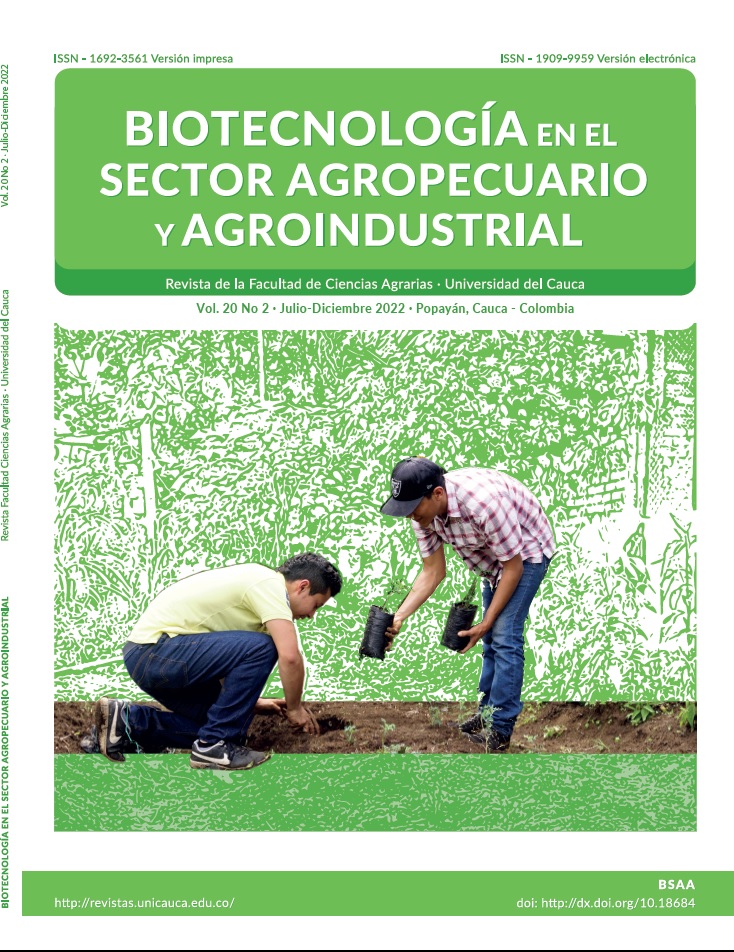Remoción de compuestos fenólicos totales de aguas del beneficio de café sobre una matriz de origen natural
Resumen
El uso de distintos materiales para la retención de diferentes tipos de moléculas es ampliamente conocido. Sin embargo, en la actualidad, ha surgido la necesidad de usar materiales de origen natural dadas sus características intrínsecas como ser renovables, económicas y amigables con el medio ambiente. Este estudio tuvo como objetivo disminuir el contenido de compuestos fenólicos en aguas residuales del beneficio del café. Para esto, se determinó el porcentaje de retención de dichos compuestos en Luffa cylindrica (estropajo) como material adsorbente. Se evaluó la influencia del pH, tamaño de partícula y tiempo de contacto bajo diseño experimental 23. Se logró un porcentaje de retención de fenoles totales de 97,8% a pH 7,0, tamaño de partícula 850 μm y 2 h de exposición. El comportamiento cinético obtenido corresponde a un modelo de pseudo segundo orden y la adsorción de compuestos fenólicos totales por L. cylindrica está representado por la isoterma de Freundlich. Adicionalmente, se logró disminuir el valor de otros índices de contaminación como DQO y turbidez, por tanto, el tratamiento con L. cylindrica se constituye en una valiosa alternativa para el tratamiento de aguas provenientes del beneficio del café.
Descargas
Disciplinas:
QuímicaLenguajes:
AmbientalReferencias bibliográficas
ABDELWAHAB, O.; AMIN, N.K. Adsorption of phenol from aqueous solutions by Luffa cylindrica fibers: Kinetics, isotherm and thermodynamic studies. Egyptian Journal of Aquatic Research, v. 39, 2013, p. 215–223.http://dx.doi.org/10.1016/j.ejar.2013.12.011
ARANA, JORGE; GONZÁLES, SEBASTIÁN; NAVARRETE, LUISA; CAICEDO, OBRADITH. Luffa cylindrica as a natural adsorbent of cyanide ion in aqueous medium. DYNA, v. 84, n. 201, 2017, p. 210-215.https://doi.org/10.15446/dyna.v84n201.60070
ARRIEL-TORRES, JULIANA; BATISTA-CHAGAS, PRICILA; SILVA, MARIA-CRISTINA; DONIZETE-DOS SANTOS, CUSTODIO; DUARTE-CORREA, ANGELITA. Enzymatic oxidation of phenolic compounds in coffee processing wastewater. Water Science and Technology, v. 73, n. 1, 2015, p. 39-50. https://doi.org/10.2166/wst.2015.332
BAHARLOUEI, ATEFEH; JALILNEJAD, EELHAM; SIROUSAZAR, MOHAMMAD. Fixed-bed column performance of methylene blue biosorption by Luffa cylindrica: statistical and mathematical modeling. Chemical Engineering Communications, v. 205, n. 11, 2018, p. 1537–1554. https://doi.org/10.1080/00986445.2018.1460364
BATISTA-CHAGAS, PRICILA; ARRIEL-TORRES, JULIANA; SILVA, MARIA-CRISTINA.; DUARTE-CORREA, ANGELITA. Immobilized soybean hull peroxidase for the oxidation of phenolic compounds in coffee processing wastewater. International Journal. Biological Macromolecules, v. 81, 2015, p. 568–575.https://doi.org/10.1016/j.ijbiomac.2015.08.061
BERA, SOUNAK; MOHANTY, KKAUSTUBHA. Areca nut (Areca catechu) husks and Luffa (Luffa cylindrica) sponge as microbial immobilization matrices for efficient phenol degradation. Journal of Water Process Engineering, v. 33, 2020, e 100999.https://doi.org/10.1016/j.jwpe.2019.100999
CAICEDO, OBRADITH; DEVIA-RAMIREZ, JENCY; MALAGÓN, ANDRÉS. Adsorption of common laboratory dyes using natural fibers from Luffa cylindrica. Journal of Chemical Education, v. 95, n. 12), 2018, e 2233.https://doi.org/10.1021/acs.jchemed.8b00156
CASTRO, A.C.C.M.; ODA, F.B.; ALMEIDA-CINCOTTO, M.G.J.; DAVANGO, M.G.; CHIARI-ANDRÉO, B.G.; CICARELLI, R.M.B.; PECCININI, R.G.; ZOCOLO, G.J.; RIBEIRO, P.R.V.; CORREA, M.A.; ISAAC, V.L.B.; SANTOS A.G. Green coffee seed residue: A sustainable source of antioxidant compounds. Food Chemistry, v. 246, 2018, p. 48-57.https://doi.org/10.1016/j.foodchem.2017.10.153
DE SOUSA-NETO, JOSÉ; OLIVEIRA, J. DE A.N.; SIQUIERA, L.M.C.; ALVES, N. VANESSA. Selective Extraction and Determination of Chromium Concentration Using Luffa cylindrica Fibers as Sorbent and Detection by FAAS. Hindawi Journal of Chemistry, v.1679419, 2019, ID 1679419, e. 6. https://doi.org/10.1155/2019/1679419
DEMIR, HASAN; DEVECI, MERYEM-ARZU. Comparison of Ultrasound and Conventional Technique for Removal of Methyl Orange by Luffa Cylindrica Fibers. Arabian Journal for Science and Engineering, v. 43, 2018, p. 5881-5889.https://doi.org/10.1007/s13369-017-3050-9
FERNANDES, A.S.; MELLO, F.V.C.; THODE-FILHO, S.; CARPES, R.M.; HONÓRIO, J.G.; MARQUES, M.R.C.; FELZENSZWALB, I.; FERRAZ, E.R.A. Impacts of discarded coffee waste on human and environmental health. Ecotoxicology and Environmental Safety, v.141, 2017, p. 30-36.https://doi.org/10.1016/j.ecoenv.2017.03.011
JANISSEN, BRENDAN; HUYNH, TIEN. Chemical composition and value-adding applications of coffee industry byproducts: A review. Resources, Conservation & Recycling, v.128, 2018, p.110–117.https://doi.org/10.1016/j.resconrec.2017.10.001
LIATSOU, IOANNA; CONSTANTINOU, PANAYIOTA; PASHALIDIS, IOANNIS. Copper Binding by Activated Biochar Fibres Derived from Luffa cylindrical. Water Air Soil Pollut, v. 228, n. 255, 2017, p . 1-7.https://doi.org/10.1007/s11270-017-3411-8
LIATSOU, IOANNA; PASHALIDISA, IOANNIS; DOSCHEB, CCARSTEN. Cu(II) adsorption on 2-thiouracil-modified Luffa cylindrica biochar fibres from artificial and real samples, and competition reactions with U(VI). Journal of Hazardous Materials, v. 383, 2020, e 120950.https://doi.org/10.1016/j.jhazmat.2019.120950
LIU, QING-SONG; ZHENG, TONG; WANG, PENG; JIANG, JI-PING; LI, NAN. Adsorption isotherm, kinetic and mechanism studies of some substituted phenols on activated carbon fibers. Chemical Engineering Journal, v. 157, n. 2–3, 2010, p. 348–356.https://doi.org/10.1016/j.cej.2009.11.013
MIRÓN-MÉRIDA, VICENTE; YAÑEZ-FERNANDEZ, JORGE; MONTAÑEZ-BARRAGAN, BRENDA; BARRAGÁN-HUERTAS, BLANCA. Valorization of coffee parchment waste (Coffea arabica) a source of caffeine and phenolic compounds in antifungal gellan gum films. LWT - Food Science and Technology, v. 101, 2018, p. 167–174.https://doi.org/10.1016/j.lwt.2018.11.013
MOHAMMADI, SAYED-ZIA; DARIJANI, ZAHRA; KARIMI-MOHAMMAD, ALI. Fast and efficient removal of phenol by magnetic activated carbon cobalt nanoparticles. Journal of Alloys and compounds, v. 832, 2020, e 154942.https://doi.org/10.1016/j.jallcom.2020.154942
PERALTA, YURY; SANABRIA, NANCY; CARRIAZO, JOSÉ; MORENO, SONIA; MOLINA, RAFAEL. Catalytic wet hydrogen peroxide oxidation of phenolic compound in coffee wastesater using Al-Fe- pillared clay extrudates. Desalination and Water Treatment, v. 55, n. 3, 2015, p. 647-654. https://doi.org/10.1080/19443994.2014.920279
RIBEIRO-LACERDA, M.F.A.; MARQUES-LOPEZ, FLAVIO; SARTORATTO, ADILSON; NUNES, PONEZI-ALEXANDRE; VIEIRA-THOMAZ, DOUGLAS; SCHIMIDT, FERNANDO; FONTES-SANTIAGO, MARIANGELA. Stability of immobilized laccase on Luffa Cylindrica fibers and assessment of synthetic hormone degradation. Preparative Biochemistry and Biotechnology, v. 49, n. 1, 2018, p. 58–63. https://doi.org/10.1080/10826068.2018.1525568
RODRIGUEZ-PÉREZ, SILVIA; PEREZ-SILVA, ROSA; FERNÁNDEZ-BOIZÁN, MAIKEL. Estudio de la biodegradabilidad anaerobia de las aguas residuales del benefico húmedo del café. Interciencia, v. 25, n. 8, 2000, p. 386-390.
SÁNCHEZ-GÓMEZ, CARLOS; SUAZA-MONTALVO, ANDREA; CARO-PARRADO, MIGUEL; SANCHEZ-SAENZ, CAROLINA. Phenolic content analysis of coffee leaves subjected to HTST and convective drying. Revista U.D.C.A Actualidad & Divulgación Científica, v. 21, n. 1, 2018, p.81-88. https://doi:10.31910/rudca.v21.n1.2018.665
SANZ, J.R.; RAMÍREZ, C.A.; OLIVEROS, C.E. Evaluación del impacto ambiental de una central comunitaria para el beneficio de café utilizando la tecnología ecomill. Cenicafé, v. 70, n. 1, 2019, p. 18-29.


 Español
Español Inglés
Inglés





















.png)



